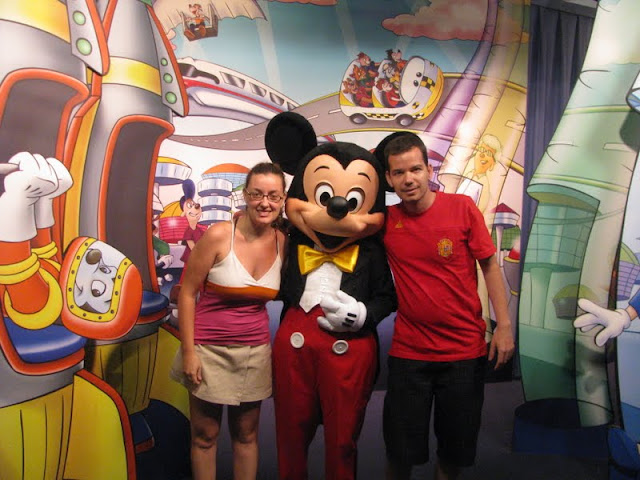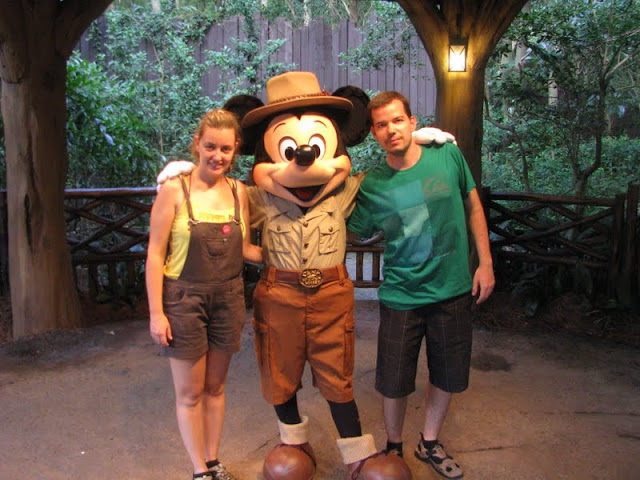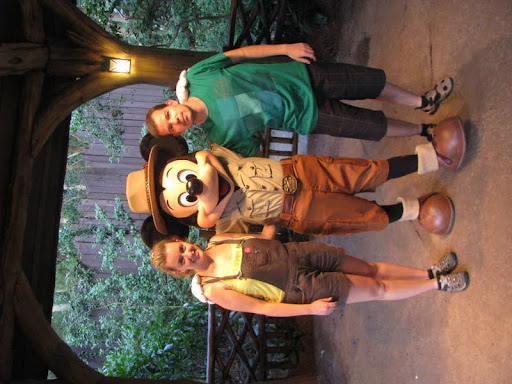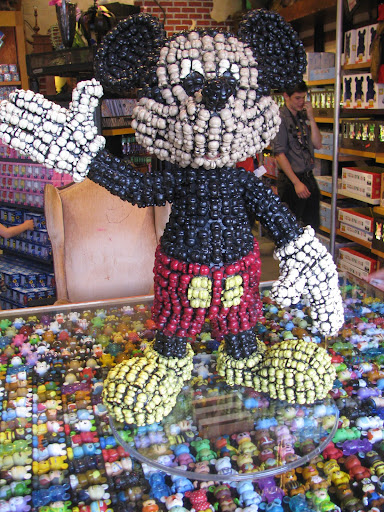Mickey Mouse is a cartoon character created in 1928 by Walt Disney and Ub Iwerks at The Walt Disney Studio. Mickey is an anthropomorphic black mouse and typically wears red shorts, large yellow shoes, and white gloves. He is one of the most recognizable cartoon characters in the world and is the mascot of  The Walt Disney Company.
The Walt Disney Company.
Mickey debuted in November 1928 in the animated cartoon Steamboat Willie after initially appearing in test screenings earlier that year. He went on to appear in over 130 films including The Band Concert (1935), Brave Little Tailor (1938), and Fantasia (1940). Mickey appeared primarily in short films, but also in a few feature-length films. Nine of Mickey's cartoons were nominated for the Academy Award for Best Animated Short Film, one of which, Lend a Paw, won the award in 1942. In 1978, Mickey became the first cartoon character to have a star on the Hollywood Walk of Fame.
Beginning 1930, Mickey has also been featured extensively as a comic strip character. His self-titled newspaper strip, drawn primarily by Floyd Gottfredson, ran for 45 years. Mickey has also appeared in comic books and in television series such as The Mickey Mouse Club (1955–1996) and others. He also appears in other media such as video games as well as merchandising, and is a meetable character at the Disney parks.
Mickey typically appears alongside his girlfriend Minnie Mouse, his pet dog Pluto, his friends Horace Horsecollar, Donald Duck, and Goofy, and his nemesis Pete among others. Originally characterized as a mischievous anti hero, Mickey's increasing popularity led to his being rebranded as an everyman, usually seen as an ever cheerful, yet shy role model. In 2009, Disney announced that they will begin to rebrand the character again by putting less emphasis on his pleasant, cheerful side and reintroducing the more mischievous and adventurous sides of his personality, starting with the video game Epic Mickey.
model. In 2009, Disney announced that they will begin to rebrand the character again by putting less emphasis on his pleasant, cheerful side and reintroducing the more mischievous and adventurous sides of his personality, starting with the video game Epic Mickey.
Mickey Mouse was created as a replacement for Oswald the Lucky Rabbit, an earlier cartoon character created by the Disney studio for Charles Mintz of Universal Studios. In the spring of 1928, with the series going strong, Disney asked Mintz for an increase in the budget. But Mintz instead demanded that Walt take a 20 percent budget cut, and as leverage, he reminded Disney that Universal owned the character, and revealed that he had already signed most of Disney's current employees to his new contract. Mintz owned Oswald and thought he had Disney over a barrel. Angrily, Disney refused the deal and returned to produce the final Oswald cartoons he contractually owed Mintz. Disney was dismayed at the betrayal by his staff, but determined to restart from scratch. The new Disney Studio initially consisted of animator Ub Iwerks and a loyal apprentice artist, Les Clark, who together with Wilfred Jackson were among the few who remained loyal to Walt. One lesson Disney learned from the experience was to thereafter always make sure that he owned all rights to the characters produced by his company.
In the spring of 1928, Disney asked Ub Iwerks to start drawing up new character ideas. Iwerks tried sketches of various animals, such as dogs and cats, but none of these appealed to Disney. A f emale cow and male horse were also rejected. They would later turn up as Clarabelle Cow and Horace Horsecollar. (A male frog, also rejected, would later show up in Iwerks' own Flip the Frog series.) Walt Disney got the inspiration for Mickey Mouse from his old pet mouse he used to have on his farm. In 1925, Hugh Harman drew some sketches of mice around a photograph of Walt Disney. These inspired Ub Iwerks to create a new mouse character for Disney. "Mortimer Mouse" had been Disney's original name for the character before his wife, Lillian, convinced him to change it, and ultimately Mickey Mouse came to be. Actor Mickey Rooney has claimed that, during his Mickey McGuire days, he met cartoonist Walt Disney at the Warner Brothers studio, and that Disney was inspired to name Mickey Mouse after him.
emale cow and male horse were also rejected. They would later turn up as Clarabelle Cow and Horace Horsecollar. (A male frog, also rejected, would later show up in Iwerks' own Flip the Frog series.) Walt Disney got the inspiration for Mickey Mouse from his old pet mouse he used to have on his farm. In 1925, Hugh Harman drew some sketches of mice around a photograph of Walt Disney. These inspired Ub Iwerks to create a new mouse character for Disney. "Mortimer Mouse" had been Disney's original name for the character before his wife, Lillian, convinced him to change it, and ultimately Mickey Mouse came to be. Actor Mickey Rooney has claimed that, during his Mickey McGuire days, he met cartoonist Walt Disney at the Warner Brothers studio, and that Disney was inspired to name Mickey Mouse after him.
Ub Iwerks designed Mickey's body out of circles in order to make the character simple to animate. Disney employees John Hench and Marc Davis believed that this design was part of Mickey's success – it made him more dynamic and appealing to audiences. Mickey's circular design is most noticeable in his ears, which in traditional animation, always appear circular no matter which way Mickey faces. This made Mickey easily recognizable to audiences and made his ears an unofficial personal trademark. Even today, the symbol is often used by the Disney company to represent Mickey. (see Hidden Mickey) This later created a dilemma for toy creators who had to recreate a three dimensional Mickey. In animation in the 1940s Mickey's ears were animated in perspective.

Animator Fred Moore would later redesign Mickey's body away from its circular design to a pear-shape design. Colleague Ward Kimball praised Moore for being the first animator to break from Mickey's "rubber hose, round circle" design. Although Moore himself was nervous at first about changing Mickey, Walt Disney liked the new design and told Moore "that's the way I want Mickey to be drawn from now on."
Each of Mickey's hands have only three fingers and a thumb. Disney said that this was both an artistic and financial decision, explaining "Artistically five digits are too many for a mouse. His hand would look like a bunch of bananas. Financially, not having an extra finger in each of 45,000 drawings that make up a six and one half minute short has saved the Studio millions." In the film The Opry House (1929), Mickey was given his white gloves which were a simple way of contrasting his naturally black hands against his black body.
Mickey's eyes, as drawn in Plane Crazy and The Gallopin' Gaucho, were large and white and defined by black outlines. In Steamboat Willie the black outlines were removed, although the upper edges still contrasted with his head. Mickey's eyes were later re-imagined as only consisting of the small black dots which were his pupils, while what was the upper edges of his eyes became a hairline. This is evident only when Mickey blinks. Fred Moore later redesigned the eyes to be small white eyes with pupils and gave his face a caucasian skin tone instead of plain white. This new Mickey first appeared in 1938 on the cover of a party program, and in animation the following year with the release of The Pointer. Mickey is sometimes given eyebrows as seen in The Simple Things (1953) and in the comic strip, although he does not have eyebrows in his most recent appearances.
Besides Mickey's gloves and shoes, he typically wears only a pair of shorts with two large buttons in the front. Although the animated Mickey was seen only in black and white for over seven years, print images confirmed that the shorts were red. When Mickey is not wearing his red shorts, he is often still wearing red clothing. This includes a red bandmaster coat (The Band Concert, The Mickey Mouse Club), red overalls (Clock Cleaners, Boat Builders), a red cloak (Fantasia, Fun and Fancy Free), a red coat (Squatter's Rights, Mickey's Christmas Carol), and a red shirt (Mickey Down Under, The Simple Things).
A large part of Mickey's screen persona is his famously shy, falsetto voice. From his first speaking role in The Karnival Kid onward, Mickey was voiced by Walt Disney himself, a task in which Disney took great personal pride. (Carl Stalling and Clarence Nash allegedly did some uncredited ADR for Mickey in a few early shorts as well.) However, by 1946, Disney was becoming too busy with running the studio to do regular voice work which means he could not do Mickey's voice anymore (and as it is speculated his cigarette habit had damaged his voice over the years), and during the recording of the Mickey and the Beanstalk section of Fun and Fancy Free, Mickey's voice was handed over to veteran Disney musician and actor Jimmy MacDonald. (Both Disney's and MacDonald's voices can be heard on the final soundtrack.) MacDonald voiced Mickey in the remainder of the theatrical shorts, and for various television and publicity projects up until his retirement in the mid-1970s, although Walt voiced Mickey again for the introductions of the original 1954—1959 The Mickey Mouse Club TV series and the "Fourth Anniversary Show" episode of the Disneyland TV series aired on September 11, 1958. 1983's Mickey's Christmas Carol marked the theatrical debut of the late Wayne Allwine as Mickey Mouse, who was the voice of Mickey until his death in 2009. Allwine was, incidentally, married to Russi Taylor, the current voice of Minnie Mouse. Les Perkins did the voice of Mickey in the TV special Down and Out with Donald Duck released in 1987.
speaking role in The Karnival Kid onward, Mickey was voiced by Walt Disney himself, a task in which Disney took great personal pride. (Carl Stalling and Clarence Nash allegedly did some uncredited ADR for Mickey in a few early shorts as well.) However, by 1946, Disney was becoming too busy with running the studio to do regular voice work which means he could not do Mickey's voice anymore (and as it is speculated his cigarette habit had damaged his voice over the years), and during the recording of the Mickey and the Beanstalk section of Fun and Fancy Free, Mickey's voice was handed over to veteran Disney musician and actor Jimmy MacDonald. (Both Disney's and MacDonald's voices can be heard on the final soundtrack.) MacDonald voiced Mickey in the remainder of the theatrical shorts, and for various television and publicity projects up until his retirement in the mid-1970s, although Walt voiced Mickey again for the introductions of the original 1954—1959 The Mickey Mouse Club TV series and the "Fourth Anniversary Show" episode of the Disneyland TV series aired on September 11, 1958. 1983's Mickey's Christmas Carol marked the theatrical debut of the late Wayne Allwine as Mickey Mouse, who was the voice of Mickey until his death in 2009. Allwine was, incidentally, married to Russi Taylor, the current voice of Minnie Mouse. Les Perkins did the voice of Mickey in the TV special Down and Out with Donald Duck released in 1987.
Bret Iwan, a former Hallmark greeting card artist, is the current voice of Mickey. His early recordings in 2009 included work for the Disney Cruise Line, Mickey toys, Theme Parks, and also the Disney on Ice: Celebrations! ice show. His first video game voiceover of Mickey Mouse can be found on Kingdom Hearts: Birth by Sleep, a video game for PlayStation Portable. He has also voiced the character in the next games for the Kingdom Hearts series. Bret also does the vocal effects of Mickey in Epic Mickey.
As the official Walt Disney mascot, Mickey has played a central role in the Disney parks sinc e the opening of Disneyland in 1955. As with other characters, Mickey is often portrayed by a non-speaking costumed actor. In this form he has participated in ceremonies and countless parades. A popular activity with guests is getting to meet and pose for photographs with the mouse. As of the presidency of George W. Bush, Mickey has met every U.S. President since Harry Truman, with the exception of Lyndon B. Johnson.
e the opening of Disneyland in 1955. As with other characters, Mickey is often portrayed by a non-speaking costumed actor. In this form he has participated in ceremonies and countless parades. A popular activity with guests is getting to meet and pose for photographs with the mouse. As of the presidency of George W. Bush, Mickey has met every U.S. President since Harry Truman, with the exception of Lyndon B. Johnson.
Mickey also features in several specific attractions at the Disney parks. Mickey's Toontown (Disneyland, Tokyo Disneyland, Magic Kingdom as "Mickey's Toontown Fair") is a themed land which is a recreation of Mickey's neighborhood. Buildings are built in a cartoon style and guests can visit Mickey or Minnie's houses, Donald Duck's boat, or Goofy's garage. This is a common place to meet the characters.
Mickey's PhilharMagic (Magic Kingdom, Tokyo Disneyland, Hong Kong Disneyland) is a 4-D film which features Mickey in the familiar role of symphony conductor. At Main Street Cinema everal of Mickey's short films are shown on a rotating basis; the sixth film is always Steamboat Willie. Mickey plays a central role in Fantasmic! (Disneyland Resort, Disney's Hollywood Studios) a live nighttime show which famously features Mickey in his role as the Sorcerer's Apprentice. Mickey was also a central character in the now defunct Mickey Mouse Revue (Magic Kingdom, Tokyo Disneyland) which was an indoor show featuring animatronic characters. Mickey's face currently graces the Mickey's Fun Wheel at Disney California Adventure Park
In addition to Mickey's overt presence in the parks, numerous images of him are also subtly included in sometimes unexpected places. This phenomenon is known as "Hidden Mickey."
Mickey debuted in November 1928 in the animated cartoon Steamboat Willie after initially appearing in test screenings earlier that year. He went on to appear in over 130 films including The Band Concert (1935), Brave Little Tailor (1938), and Fantasia (1940). Mickey appeared primarily in short films, but also in a few feature-length films. Nine of Mickey's cartoons were nominated for the Academy Award for Best Animated Short Film, one of which, Lend a Paw, won the award in 1942. In 1978, Mickey became the first cartoon character to have a star on the Hollywood Walk of Fame.
Beginning 1930, Mickey has also been featured extensively as a comic strip character. His self-titled newspaper strip, drawn primarily by Floyd Gottfredson, ran for 45 years. Mickey has also appeared in comic books and in television series such as The Mickey Mouse Club (1955–1996) and others. He also appears in other media such as video games as well as merchandising, and is a meetable character at the Disney parks.
Mickey typically appears alongside his girlfriend Minnie Mouse, his pet dog Pluto, his friends Horace Horsecollar, Donald Duck, and Goofy, and his nemesis Pete among others. Originally characterized as a mischievous anti hero, Mickey's increasing popularity led to his being rebranded as an everyman, usually seen as an ever cheerful, yet shy role
Mickey Mouse was created as a replacement for Oswald the Lucky Rabbit, an earlier cartoon character created by the Disney studio for Charles Mintz of Universal Studios. In the spring of 1928, with the series going strong, Disney asked Mintz for an increase in the budget. But Mintz instead demanded that Walt take a 20 percent budget cut, and as leverage, he reminded Disney that Universal owned the character, and revealed that he had already signed most of Disney's current employees to his new contract. Mintz owned Oswald and thought he had Disney over a barrel. Angrily, Disney refused the deal and returned to produce the final Oswald cartoons he contractually owed Mintz. Disney was dismayed at the betrayal by his staff, but determined to restart from scratch. The new Disney Studio initially consisted of animator Ub Iwerks and a loyal apprentice artist, Les Clark, who together with Wilfred Jackson were among the few who remained loyal to Walt. One lesson Disney learned from the experience was to thereafter always make sure that he owned all rights to the characters produced by his company.
In the spring of 1928, Disney asked Ub Iwerks to start drawing up new character ideas. Iwerks tried sketches of various animals, such as dogs and cats, but none of these appealed to Disney. A f
Ub Iwerks designed Mickey's body out of circles in order to make the character simple to animate. Disney employees John Hench and Marc Davis believed that this design was part of Mickey's success – it made him more dynamic and appealing to audiences. Mickey's circular design is most noticeable in his ears, which in traditional animation, always appear circular no matter which way Mickey faces. This made Mickey easily recognizable to audiences and made his ears an unofficial personal trademark. Even today, the symbol is often used by the Disney company to represent Mickey. (see Hidden Mickey) This later created a dilemma for toy creators who had to recreate a three dimensional Mickey. In animation in the 1940s Mickey's ears were animated in perspective.
Animator Fred Moore would later redesign Mickey's body away from its circular design to a pear-shape design. Colleague Ward Kimball praised Moore for being the first animator to break from Mickey's "rubber hose, round circle" design. Although Moore himself was nervous at first about changing Mickey, Walt Disney liked the new design and told Moore "that's the way I want Mickey to be drawn from now on."
Each of Mickey's hands have only three fingers and a thumb. Disney said that this was both an artistic and financial decision, explaining "Artistically five digits are too many for a mouse. His hand would look like a bunch of bananas. Financially, not having an extra finger in each of 45,000 drawings that make up a six and one half minute short has saved the Studio millions." In the film The Opry House (1929), Mickey was given his white gloves which were a simple way of contrasting his naturally black hands against his black body.
Mickey's eyes, as drawn in Plane Crazy and The Gallopin' Gaucho, were large and white and defined by black outlines. In Steamboat Willie the black outlines were removed, although the upper edges still contrasted with his head. Mickey's eyes were later re-imagined as only consisting of the small black dots which were his pupils, while what was the upper edges of his eyes became a hairline. This is evident only when Mickey blinks. Fred Moore later redesigned the eyes to be small white eyes with pupils and gave his face a caucasian skin tone instead of plain white. This new Mickey first appeared in 1938 on the cover of a party program, and in animation the following year with the release of The Pointer. Mickey is sometimes given eyebrows as seen in The Simple Things (1953) and in the comic strip, although he does not have eyebrows in his most recent appearances.
Besides Mickey's gloves and shoes, he typically wears only a pair of shorts with two large buttons in the front. Although the animated Mickey was seen only in black and white for over seven years, print images confirmed that the shorts were red. When Mickey is not wearing his red shorts, he is often still wearing red clothing. This includes a red bandmaster coat (The Band Concert, The Mickey Mouse Club), red overalls (Clock Cleaners, Boat Builders), a red cloak (Fantasia, Fun and Fancy Free), a red coat (Squatter's Rights, Mickey's Christmas Carol), and a red shirt (Mickey Down Under, The Simple Things).
A large part of Mickey's screen persona is his famously shy, falsetto voice. From his first
Bret Iwan, a former Hallmark greeting card artist, is the current voice of Mickey. His early recordings in 2009 included work for the Disney Cruise Line, Mickey toys, Theme Parks, and also the Disney on Ice: Celebrations! ice show. His first video game voiceover of Mickey Mouse can be found on Kingdom Hearts: Birth by Sleep, a video game for PlayStation Portable. He has also voiced the character in the next games for the Kingdom Hearts series. Bret also does the vocal effects of Mickey in Epic Mickey.
As the official Walt Disney mascot, Mickey has played a central role in the Disney parks sinc
Mickey also features in several specific attractions at the Disney parks. Mickey's Toontown (Disneyland, Tokyo Disneyland, Magic Kingdom as "Mickey's Toontown Fair") is a themed land which is a recreation of Mickey's neighborhood. Buildings are built in a cartoon style and guests can visit Mickey or Minnie's houses, Donald Duck's boat, or Goofy's garage. This is a common place to meet the characters.
Mickey's PhilharMagic (Magic Kingdom, Tokyo Disneyland, Hong Kong Disneyland) is a 4-D film which features Mickey in the familiar role of symphony conductor. At Main Street Cinema everal of Mickey's short films are shown on a rotating basis; the sixth film is always Steamboat Willie. Mickey plays a central role in Fantasmic! (Disneyland Resort, Disney's Hollywood Studios) a live nighttime show which famously features Mickey in his role as the Sorcerer's Apprentice. Mickey was also a central character in the now defunct Mickey Mouse Revue (Magic Kingdom, Tokyo Disneyland) which was an indoor show featuring animatronic characters. Mickey's face currently graces the Mickey's Fun Wheel at Disney California Adventure Park
In addition to Mickey's overt presence in the parks, numerous images of him are also subtly included in sometimes unexpected places. This phenomenon is known as "Hidden Mickey."
You have read this article with the title Mickey Mouse. You can bookmark this page URL https://tiogatalk.blogspot.com/2011/11/mickey-mouse.html. Thanks!
Write by:
AN - Thursday, November 10, 2011










Comments "Mickey Mouse"
Post a Comment